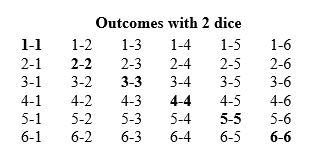Last updated on May 29, 2024
Flexibility is a term you will often hear used around a backgammon board, particularly by intermediate and advanced players. But what is flexibility with respect to backgammon? Flexibility is the way in which checkers are arranged to allow the greatest number of dice rolls to play with favourable results for yourself and the least favourable for your opponent. Unlike chess, where all factors of play are visible at all times, backgammon has the element of luck due to the randomness of the dice. In backgammon, you never have any control over what numbers may appear, so there is a strong element of uncertainty.
A novice or a casual observer of the game might consider that luck is the controlling factor in backgammon. However, although luck can certainly influence the outcome of a single game, in the long-run strategy and skill reigns supreme. That said, it is possible to influence your own luck during play. Obviously, cheating is one way, by using loaded dice or manipulating the throw, but you don’t need to cheat to improve your luck. Flexibility is the key. The truth is that a player who adopts a more flexible position gets more luck out of the dice than the one who doesn’t. In fact, it might even seem that you are making your own luck during a backgammon game if you play with flexibility.
Flexible positions
How do you know if you have a flexible position during a backgammon game? Firstly, look at the distribution of your checkers on the board. Are they heavily stacked across a couple of points? If so, your position is not flexible. Because the checkers are concentrated the movement options are limited to a few starting positions on your next roll. If the checkers are more evenly spread across the board the options for the starting positions of a move are far greater. The idea is to generally keep only four checkers as a maximum number on any single point you occupy on the backgammon board.
In normal play, there are 36 possible combinations for the roll of two six-sided dice. If we exclude duplicate values, such as 1-2 and 2-1, there are 21 possible combinations for each turn of play. However, in the opening move, this is reduced to 15 possible combinations as doubles are excluded. By maintaining a flexible position, you have more options to use more of those combinations to your advantage on any given roll.
Example
Let’s look at an example to demonstrate how flexibility helps us make use of more of the dice roll combinations that may turn up. Imagine an opening roll of 3-2. Most beginners would want to play safe and would look for the safest position (meaning the one that doesn’t leave a blot). The typical response for a novice would be to move a checker from the mid-point down to the 8-point (13-8). It is not the worst move possible, but it does limit the flexibility of the next roll as you only have four points from which to make a move.
A more flexible position would be gained by moving 24/21, 13/11. This develops both sides of the board. The blot in on the 21-point is exposed, but not much ground is lost if it is subsequently hit. Your opponent would likely only hit it if they could also secure the point. The blot on the 11-point is relatively safe as it can only be hit with a total roll of 10 (6-4 or 4-6). You now have checkers spread across six points which gives additional starting points from which to make a move. Flexibility is not about leaving random blots across the board, but rather giving yourself more sensible options as you move according to your overall strategy.
Related content
Backgammon rules are available on this link.



True, good points. In backgammon, it is all about making calculated risks. If you play to safe, and many backgammon beginners do, you will end up with candlesticks and limited options. It might seem like your bad luck or your opponents good luck, but it is really down to the options you have when making a move. The best advice in backgammon is, take chances, but try not to leave direct hits, where possible. There are a lot of really good backgammon playing guides on Deluxe Backgammon, please keep them coming.
Hi Martha, you are right about backgammon beginners, they always play too safe. The candlesticks can get ridiculously high and they wonder why they are forced into unfavourable moves. In backgammon, luck does play a part, but in the long run skill will win over luck. As you say, taking calculated risks is a good thing, but backgammon beginners should try to avoid leaving direct hits. Thanks for taking the time to comment, Jason.